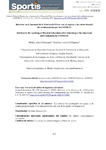Mostrar o rexistro simple do ítem
Barreras en la docencia de la Educación Física tras el regreso a las aulas después del confinamiento por la COVID 19
| dc.contributor.author | Aznar, Mónica | |
| dc.contributor.author | Gil-Espinosa, Francisco Javier | |
| dc.date.accessioned | 2022-11-22T16:42:03Z | |
| dc.date.available | 2022-11-22T16:42:03Z | |
| dc.date.issued | 2022-09-01 | |
| dc.identifier.citation | Aznar-Cebamanos, M.; Gil-Espinosa, J. (2022). Barreras en la docencia de la Educación Física tras el regreso a las aulas después del confinamiento por la COVID 19. Sportis Sci J, 8 (3), 491-513 https://doi.org/10.17979/sportis.2022.8.3.9042 | es_ES |
| dc.identifier.issn | 2386-8333 | |
| dc.identifier.uri | http://hdl.handle.net/2183/32097 | |
| dc.description.abstract | [Resumen] El 14 de marzo de 2020 se declaró el Estado de Alarma en todo el territorio español, sufriendo el sistema educativo un cambio que conllevó a reformular muchos aspectos del proceso de enseñanza-aprendizaje. En España, las Comunidades Autónomas (CCAA) asumieron la delegación de responsabilidades para actuar en su ámbito territorial y adaptar las restricciones por zonas territoriales en función de la incidencia de contagios por la Covid-19. Posteriormente, multitud de estudios abalaron la decisión del Ministerio de Educación y Formación Profesional para el curso 2020-2021, sobre la necesidad de la presencialidad de las clases, encomendando a las CCAA y centros educativos la concreción de planes de contingencia o protocolos de seguridad, con el objetivo de garantizar la máxima presencialidad posible del alumnado en Educación Secundaria. El objetivo de este trabajo es describir y conocer las dificultades que han tenido los docentes de Educación Física (EF) a la hora de impartir las clases a lo largo del curso escolar 2020-2021, con relación a cuatro dimensiones: práctica físico-deportiva, uso de instalaciones específicas, uso y limpieza de material y decisiones del equipo directivo respecto a la materia de EF. Se diseñó una encuesta ad hoc, participando un total de 740 docentes de EF de España repartidos por las 17 CCAA. Los resultados manifiestan una disminución del tiempo de compromiso motor, dificultades para trabajar algunos objetivos y criterios de evaluación por la imposibilidad de utilizar materiales o aulas específicas, como consecuencia de una disparidad de criterios y enfoques utilizados por las diferentes CCAA | es_ES |
| dc.description.abstract | [Abstract] On March 14, 2020, a State of Alarm was declared throughout Spain, and the educational system underwent a change that led to the reformulation of many aspects of the teaching-learning process. In Spain, the Autonomous Communities (AACC) assumed the delegation of responsibilities to act in their territorial scope and adapt the restrictions by territorial areas according to the incidence of Covid-19 infections. Subsequently, many studies supported the decision of the Ministry of Education and Vocational Training for the academic year 2020-2021, on the need for the attendance of educational classes, entrusting each AACC and educational center to specify contingency plans or safety protocols, with the aim of ensuring the maximum possible attendance of students in Secondary Education. The aim of this work is to describe and learn about the difficulties encountered by Physical Education (PE) teachers when teaching during the 2020-2021 school year, in relation to four dimensions: time for physical-sports practice, use of facilities, use and cleaning of material, and decisions of the management team regarding the subject of PE. An ad hoc survey was designed, with the participation of a total of 740 PE teachers in Spain, distributed among the 17 AACC. The results show a decrease in motor engagement time, difficulties in working on some objectives and evaluation criteria due to the impossibility of using specific materials or classrooms, because of a disparity of criteria and approaches used by the different AACC | es_ES |
| dc.language.iso | spa | es_ES |
| dc.publisher | Universidade da Coruña | es_ES |
| dc.relation.uri | https://doi.org/10.17979/sportis.2022.8.3.9042 | es_ES |
| dc.rights | https://creativecommons.org/licenses/by-nc-sa/4.0 | es_ES |
| dc.rights.uri | https://creativecommons.org/licenses/by-nc-nd/4.0 | |
| dc.subject | Educación física | es_ES |
| dc.subject | COVID-19 | es_ES |
| dc.subject | Educación secundaria | es_ES |
| dc.subject | Profesorado | es_ES |
| dc.subject | Barreras | es_ES |
| dc.subject | Physical education | es_ES |
| dc.subject | Teachers | es_ES |
| dc.subject | Barriers | es_ES |
| dc.subject | Secondary education | es_ES |
| dc.title | Barreras en la docencia de la Educación Física tras el regreso a las aulas después del confinamiento por la COVID 19 | es_ES |
| dc.title.alternative | Barriers in the teaching of Physical Education after returning to the classroom after lockdown by COVID 19 | es_ES |
| dc.type | info:eu-repo/semantics/article | es_ES |
| dc.rights.access | info:eu-repo/semantics/openAccess | es_ES |
| dc.date.updated | 2022-11-22T16:15:47Z | |
| UDC.journalTitle | Sportis. Scientific Journal of School Sport, Physical Education and Psychomotricity | es_ES |
| UDC.volume | Vol. 8 | es_ES |
| UDC.issue | Núm. 3 | es_ES |
| UDC.startPage | 491 | es_ES |
| UDC.endPage | 513 | es_ES |
| dc.identifier.doi | 10.17979/sportis.2022.8.3.9042 |






